When Reboarding a Personal Watercraft (PWC) After a Fall: The Proper Rolling Technique
Reboarding a personal watercraft (PWC) after taking a fall can be challenging, but it is an essential skill for every rider to master. Knowing the correct way to roll your PWC into an upright position, before attempting to reboard, can help ensure safety on the water and prevent possible damage to your watercraft. Equipping yourself with the right knowledge and technique can make for an efficient and successful reboarding process.
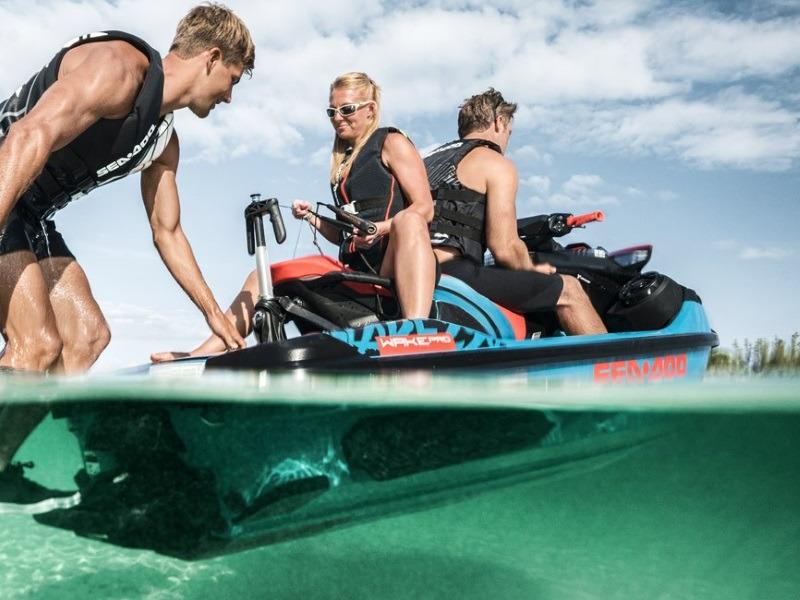
Different factors, such as environmental conditions, can affect the ease of reboarding a PWC. Being aware of these factors and taking precautionary measures to avoid falls can help minimize the need for reboarding. However, when it does become necessary, following the recommended steps and having the proper safety equipment on hand can significantly improve the experience.
Key Takeaways
- Mastering the art of reboarding a PWC ensures safety and minimizes potential damage to the watercraft.
- Environmental factors and preventive measures play a role in avoiding falls and the need for reboarding.
- Following the correct reboarding process, using proper safety equipment, and understanding common difficulties can improve the overall experience.
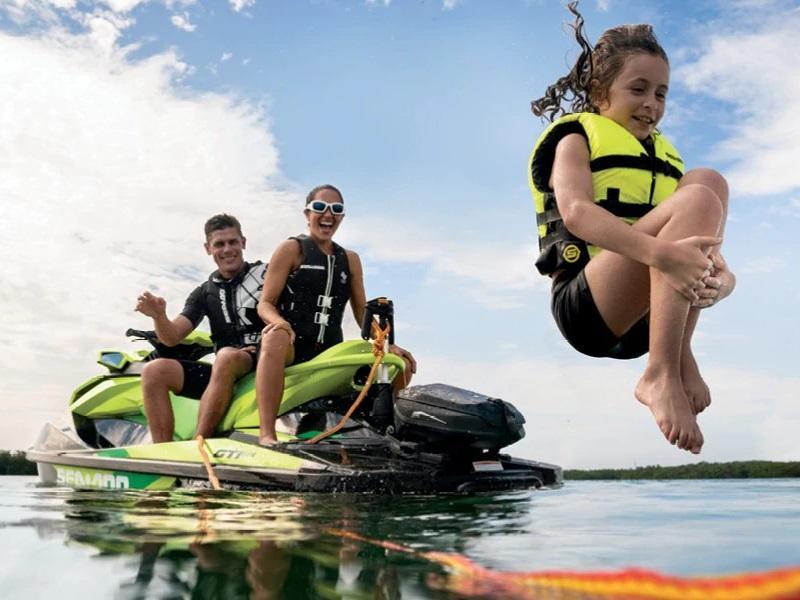
Understanding Personal Watercraft (PWC)
Personal Watercraft (PWC) are small, agile vessels that are powered by an inboard jet drive as their primary source of propulsion. They are designed to be operated by a person or persons sitting, standing, or kneeling on the craft rather than inside the vessel. PWC are great for recreational activities, offering thrill and excitement to riders.
There are various types of PWC available on the market, with some designed for single riders and others accommodating multiple passengers. These watercraft are built to be user-friendly, allowing even beginners to experience the joy of gliding across the water at high speeds. One important aspect of riding a PWC is understanding how to reboard it in case you fall off.

Reboarding a PWC after a fall can be a challenging task if not done correctly. To ensure safety, it is essential to follow proper procedures when reboarding. Firstly, assess the situation and make sure it is safe to attempt reboarding. Check for potential hazards surrounding the area, such as other watercraft or obstacles. Also, confirm that you are wearing a personal flotation device (PFD) and that the PWC's engine is turned off.
If the PWC has capsized, it must be turned upright in one direction only. To determine the proper direction to right your PWC, refer to the owner's manual or the warning sticker located on the stern of the craft. Once the PWC is upright, swim to the stern to reboard it.
In conclusion, understanding the basics of Personal Watercraft (PWC) allows you to enjoy your time on the water safely and responsibly. By learning the proper reboarding techniques, you can ensure your safety and mitigate potential risks and hazards while riding on this exciting type of watercraft.
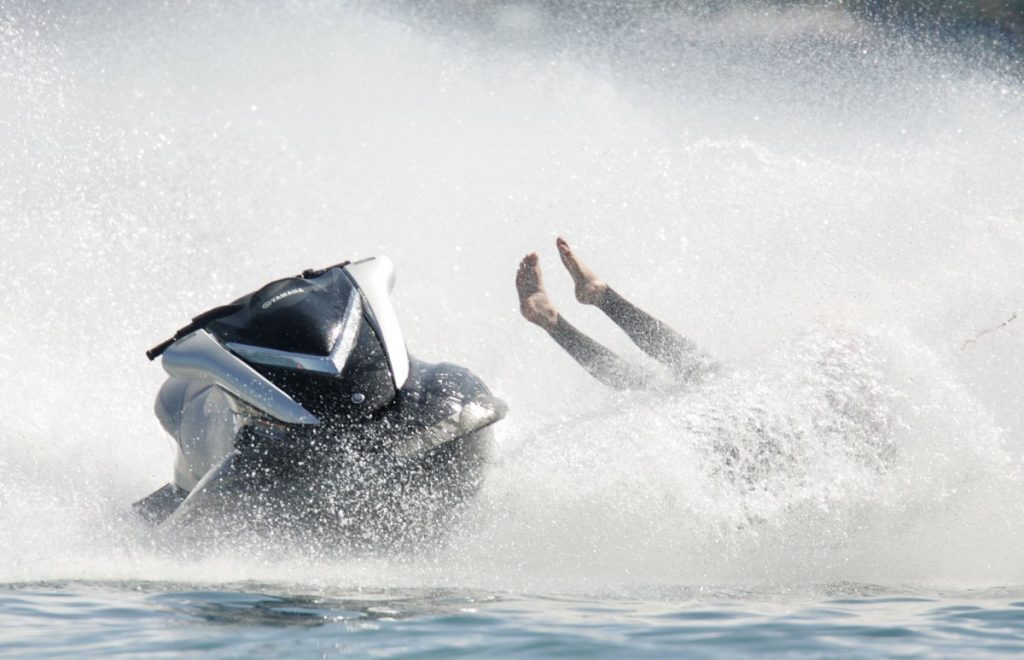
Preventive Measures to Avoid Falls
One of the best ways to ensure a safe and enjoyable PWC experience is by taking preventive measures to avoid falls. Maintaining proper balance, adhering to safety tips, wearing a lifejacket, and following the warning stickers can significantly minimize the risk of falling off a PWC.
Proper balance is crucial for maintaining control on a PWC. When riding, bend your knees slightly and keep your center of gravity low. This helps to maintain stability and absorb the shock from rough waters. It is also important to distribute weight evenly between the left and right side of the PWC. If you're riding with a passenger, ensure they hold onto the driver's waist and lean in the same direction as the driver during turns to optimize balance.
Following some basic safety tips can also help prevent falls. Always operate at a safe speed that allows you enough time to react and avoid potential collisions. Additionally, familiarize yourself with local rules and regulations, as well as the surrounding waterway conditions. Being aware of the environment, weather conditions, and any possible obstacles can significantly reduce the chances of accidents and falls.

Wearing a lifejacket is an essential safety measure when using a PWC. Lifejackets not only provide buoyancy in case of a fall, but they also offer some degree of impact protection. Make sure to wear a lifejacket that is properly fitted, comfortable, and specifically designed for use on a PWC.
Finally, pay attention to the warning stickers found on your PWC. These stickers offer valuable information regarding the safe operation of the craft, such as weight capacity, seating arrangements, and other essential guidelines. Following these warnings ensures that your PWC operates within its designed limits, reducing the likelihood of accidents and falls.
By adhering to these preventive measures, riders can significantly reduce their risk of falling off a PWC and enjoy a safer experience on the water.

Reboarding Process After A Fall
Reboarding a personal watercraft (PWC) after a fall is an essential skill for every rider to ensure their safety on the water. The first thing to remember is to ensure that the engine has stopped before approaching the PWC. If you were the driver, the safety lanyard should have been disconnected when you fell, stopping the engine automatically1.
In case the PWC has overturned completely, it is important to know how to right the PWC and reboard from the rear of the craft. Most manufacturers provide a decal at the rear or bottom of the craft that indicates the direction to roll your PWC, returning it to an upright position2.
Once the PWC is in its upright position, follow these steps to reboard:
- Approach the PWC from the correct direction, as indicated by the decal or owner's manual3.
- Pull yourself up onto the boarding platform, holding onto the handle or any designated grip area.
- Kneel on the platform and then slide onto the seat, maintaining your balance.
It is crucial to practice reboarding in a controlled environment before venturing out into open waters. Familiarize yourself with the process, ensuring that it can be executed smoothly and efficiently.
Remember that maintaining a calm and focused demeanor is vital during the reboarding process, especially in challenging situations. By developing a confident and knowledgeable approach, you can effectively handle any situation that requires reboarding your personal watercraft after a fall.

Step-by-Step Instructions to Reboard a PWC
Reboarding a personal watercraft (PWC) after a fall is an essential skill for every rider. Follow these step-by-step instructions to get back on your PWC safely and quickly.
- Ensure the engine is off: Before attempting to reboard, make sure the engine is off. As a driver, falling off should disconnect the safety lanyard and stop the engine automatically. If you are a passenger, check that the driver has stopped the engine and disconnected the safety lanyard.
- Check the reboarding direction: Most PWC manufacturers place a decal at the rear or bottom of the craft indicating the direction to roll it. If there's no decal, consult your owner's manual or contact the dealer for information.
- Roll the PWC: Rotate the vessel to a 90-degree angle to the waterline. Apply downward pressure on the handlebars while simultaneously pushing down on the opposite side of the PWC. Use your body weight and leverage to roll it onto its side. If your PWC has a reboarding ladder, use it to help pull the vessel towards you.
- Swim to the reboarding area: Approach the PWC from the rear and swim to the reboarding area near the back of the seat or ladder. Avoid approaching the vessel from the sides or front, as it can become unstable or more challenging to reboard.
- Place a knee on the seat: While holding onto the handle, place your dominant knee onto the seat. If there's a reboarding ladder or handle, use it to help support your body weight.
- Lift yourself onto the seat: With a firm grip on the handle, use your arm and leg strength to lift your body onto the seat. Swing your other leg over the PWC and find a comfortable position on the seat.
- Start the engine: Once you're securely back on the PWC, reattach the safety lanyard, and start the engine. Make sure to maintain balance and control before accelerating.
Remember to practice reboarding in calm waters to become comfortable with the process. With these instructions, you'll be prepared to reboard your personal watercraft with confidence and ease.

Tips To Right the PWC After A Fall
Falling off a personal watercraft (PWC) can happen to even the most experienced riders. It's essential to know how to properly right the PWC in order to prevent damage and ensure a safe return to the water. Follow these tips to efficiently roll the PWC after a fall:
- Ensure safety first: Before attempting to right the PWC, make sure the engine is turned off. If you were the driver, a fall should have disconnected the safety lanyard, stopping the engine. If you were a passenger and the driver is still aboard, ensure they stop the engine and disconnect the safety lanyard. Assess the surrounding area for potential hazards, such as other watercraft or obstacles, and confirm that you are wearing a personal flotation device (PFD).
- Identify the proper rollback direction: Most manufacturers place a decal at the rear or bottom of the PWC indicating the correct direction to roll the craft to return it to an upright position. If there's no decal, consult the owner's manual, or ask the dealer for assistance. Rolling the PWC the wrong way can cause damage to the vessel.
- Roll the PWC: Once you know the correct rollback direction, swim around the PWC and firmly grab the handle or edge closest to the water. Use your body weight and momentum to roll it back upright. Be careful not to twist or jerk the craft, as this may cause additional damage.
- Reboard the PWC: With the PWC upright, approach it from the stern side and carefully pull yourself up onto your knees on the boarding platform. From there, continue pulling yourself back up onto the seat. Ensure you attach the kill switch lanyard to the kill switch and to your body or PFD before starting the engine and getting back underway.
By following these tips, you'll be able to quickly and safely right your PWC and continue enjoying your time on the water. It's always a good idea to practice reboarding and righting your PWC in calm waters to become more confident and proficient in case of an unexpected fall.

Role of Safety Equipment in Reboarding
When reboarding a personal watercraft (PWC) after a fall, it is essential to prioritize safety. Several pieces of safety equipment play a crucial role in ensuring that the process is secure and efficient.
First, the safety lanyard is a vital component in reboarding a PWC. When a rider falls off, the lanyard should be attached to their personal flotation device (PFD) and connected to the engine cut-off switch. This connection ensures that the PWC's engine stops immediately when the rider falls, preventing potential injuries caused by a running engine source.
Another essential safety measure during the reboarding process is the use of a personal flotation device (PFD). PFDs provide buoyancy and help riders stay afloat while they reboard the PWC. Additionally, they are an important safety measure for cases where the rider may be unconscious or unable to swim effectively source.
The engine cut-off switch is a critical safety feature that ensures the PWC's engine stops running when a rider falls off. As previously mentioned, the safety lanyard connects to this switch to halt the engine. This precaution is vital to eliminate the risks associated with a running engine when reboarding source.
Lastly, handlebars can also be a useful safety feature during the reboarding process. They provide support and stability, making it much easier for the rider to climb back onto the PWC. Some PWCs also have reboarding ladders or platforms that can further assist in the reboarding process. These features, combined with the safety equipment mentioned earlier, can significantly enhance the safety and ease of reboarding a PWC after a fall source.
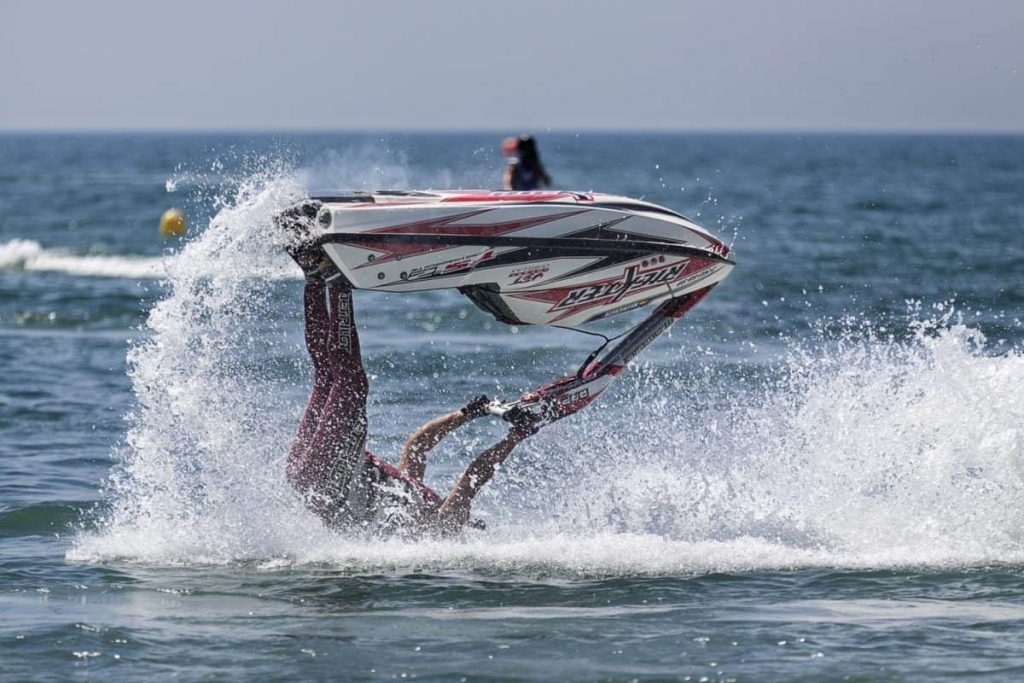
Common Difficulties While Reboarding
Reboarding a Personal Watercraft (PWC) after a fall can pose several challenges for riders. One common issue faced during the reboarding process is the difficulty of turning the PWC upright without causing damage. It is essential to rotate the PWC to a 90-degree angle to the waterline before gradually pulling it towards oneself.
Another key difficulty during reboarding can be the physical exertion involved. Riders often become tired after spending time in the water, which may result in reduced strength and coordination. Practicing reboarding techniques in calm waters can help develop the necessary skills and prepare oneself for more challenging conditions. Additionally, investing in a boarding ladder can significantly improve the ease of reboarding a PWC, especially for those who struggle with upper body strength or stamina.
Furthermore, the unstable nature of PWCs may cause them to wobble during the reboarding process, potentially resulting in multiple attempts before successfully getting back on the craft. To minimize this issue, riders should ensure their body weight is evenly distributed while boarding, aiming to maintain a low center of gravity. It's also important to attach the engine cut-off switch (ECOS) to the operator, as it helps maintain safety during falls and reboarding attempts, as mentioned by Boat Ed.
In conclusion, facing difficulties while reboarding a PWC is common, and overcoming these challenges requires knowledge and practice. By familiarizing oneself with proper techniques and utilizing tools like a boarding ladder, riders can increase their confidence and ensure safe and efficient reboarding.
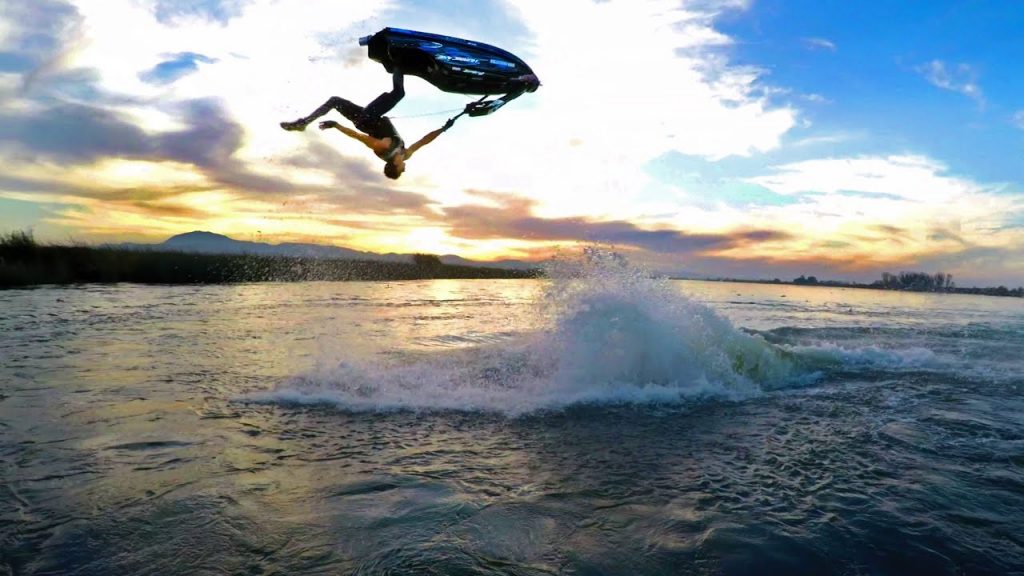
Effects of Environmental Factors on Reboarding
When reboarding a Personal Watercraft (PWC) after a fall, environmental factors play a crucial role in the process. Riders must be aware of these factors to safely get back on their PWC, minimizing any potential hazards.
Sea-Doo, a popular PWC brand, emphasizes the impact of water conditions on reboarding efforts. Choppy waters or strong currents can make it challenging for riders to maintain balance and successfully climb back onto their PWC. In contrast, calm waters allow for a smoother and more manageable reboarding experience.
The presence of hazards in the water can also complicate the reboarding process. Submerged objects, marine life, or floating debris might pose a risk to the rider or damage the PWC during reboarding efforts. It is essential to survey the immediate surroundings before attempting to get back on the PWC, addressing any potential dangers.
The 1/3 rule plays a vital role in managing one's energy when reboarding a PWC. This rule states that a person should only use one-third of their energy to swim or navigate through the water, another third to reboard the PWC, and save the last third for unforeseen circumstances that may arise. Adhering to this rule helps maintain stamina and ensures that riders have enough energy reserves to deal with potential challenges during the reboarding process.
In summary, being aware of the environmental factors and the 1/3 rule is critical to safely and efficiently reboard a PWC. Riders must be vigilant about water conditions, potential hazards, and managing their energy levels to successfully return to their Personal Watercraft after a fall.
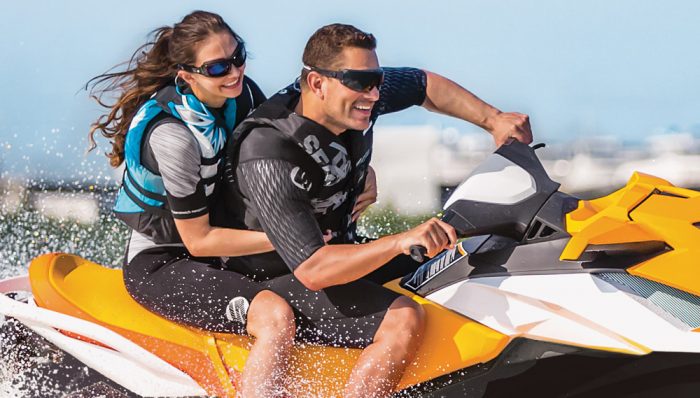
Additional Reboarding Tips and Guidelines
When reboarding a personal watercraft (PWC) after falling off, it is crucial to ensure safety and efficiency. One of the key aspects to consider is the proper rolling technique. Most manufacturers provide a decal at the rear or bottom of the craft to guide riders on how to return their PWC to its upright position source. Always consult the owner's manual or your dealer for specific instructions about your PWC.
In general, the reboarding process involves approaching the stern of the PWC on its side. Reach across the personal watercraft and grab the opposite gunwale. Roll onto your back, hold the gunwales, and kick your legs to get your knees onto the deck source. Once your knees are on the deck, pull yourself up onto the PWC carefully, avoiding the seat or handlebars, as they may not be designed to support your weight.
Practicing this reboarding technique before venturing out on the water is highly recommended. Familiarize yourself with the process to ensure that there are no surprises when a fall occurs away from shore source.
If your PWC is not equipped with a boarding step, consider adding one to facilitate smoother reboarding. A boarding step promotes safety by allowing you to grasp onto a secure, stable footing as you climb back onto your craft source.
Always observe safety guidelines, such as wearing a life jacket, while reboarding your PWC. Double-check that the engine is off before starting the process to avoid potential hazards or injury. Remember to stay visible to other watercraft users, and be aware of your surroundings during the reboarding process.
By adhering to these guidelines and practicing the proper technique, reboarding your personal watercraft becomes an efficient and safe process, ensuring an enjoyable time on the water for both you and those around you.
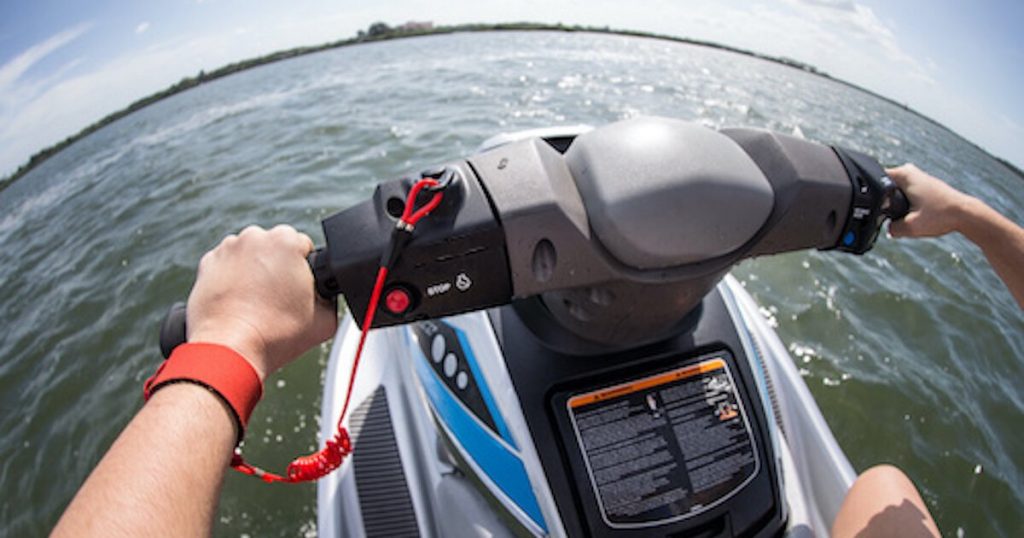
Frequently Asked Questions
What are the steps to reboarding a capsized PWC?
To reboard a capsized PWC, first ensure the engine is off and the area is clear of potential hazards. Always wear a personal flotation device (PFD) while doing so. Approach the PWC from the rear and locate the correct side to flip the watercraft upright by checking for a decal or consulting the owner's manual if needed. Use your body and swim strokes to turn the PWC in the proper direction and climb back on from the rear of the craft.
Does the direction matter while rolling a PWC after a fall?
Yes, the direction matters when rolling a PWC after a fall. Rolling it in the incorrect direction could cause further damage or pose a safety risk. Look for a decal on the PWC or consult your owner's manual to determine which direction to roll your watercraft.
How can you safely regain control of a PWC after it has overturned in water?
Before attempting to regain control of a PWC after it has overturned, first ensure that it's safe to do so and that the engine is off. Then, follow the proper steps to roll it upright and reboard from the rear. It is important to stay calm, maintain control of your body movements, and avoid panicking to ensure a safe reboarding process.
Are there any specific techniques to roll different types of PWCs?
There may be slight variations in the reboarding process for different types of PWCs. Common manufacturers may have a recommended method for their specific model or design; consult the owner's manual or visit the manufacturer's website for guidance. In general, the key steps include ensuring the engine is off, finding the correct direction to roll the PWC, and then reboarding from the rear.
What are some common mistakes to avoid while reboarding a PWC?
Some common mistakes to avoid when reboarding a PWC include: not wearing a PFD, not checking the surroundings for hazards or obstacles, attempting to reboard from the front or side instead of the rear, and disregarding the correct direction in which to roll the PWC.
How important is body position when rolling a PWC after a fall?
Body position is crucial when rolling a PWC after a fall to ensure a safe and efficient reboarding process. When flipping the PWC upright, use your body and swim strokes to apply leverage, maintaining a secure grip to prevent injury. When climbing back on the PWC, ensure your body is steady and balanced to avoid falling back into the water.
Footnotes
Charlie is Editor-in-Chief of Sea Magazine